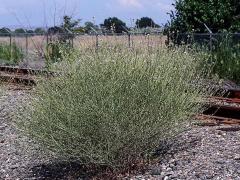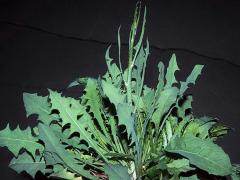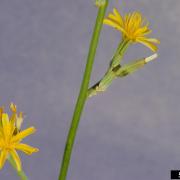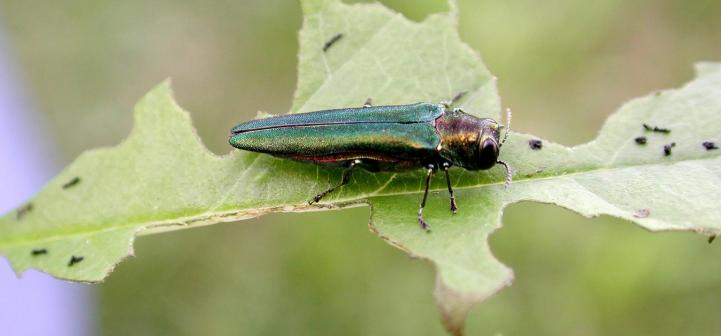Invasive Species: Chondrilla juncea, Rush Skeletonweed
Rush skeletonweed is an invasive perennial forb that can grow up to 4 ft. (1.2 m) tall. Coarse-looking, multiple stems appear leafless due to inconspicuous leaves and arise from a basal rosette of sharply lobed leaves. The lower 4 to 6 in. (10.2 to 15.2 cm) of stem is covered with coarse brown hairs. Both stem and leaves produce a milky sap when broken. Flowers are small and yellow and develop in the midsummer to fall. Mature, healthy plants can produce 1,500 flower heads and up to 20,000 seeds. Rush skeletonweed invades dry rangelands in the western United States, displaces native species, and reduces forage for livestock and wildlife. Rush skeletonweed is native to regions of Europe, Asia, and Africa and was accidentally brought to the United States as a contaminant of fodder in 1914.
What are invasive species and why should we be concerned about them?
Taxonomy: Scientific and Common Names for This Species
Asterales > Asteraceae > Chondrilla juncea L.
Synonym(s): skeletonweed
Chondrilla juncea – USDA PLANTS Profile
Distribution Maps
Rush skeletonweed – The reported distribution of this invasive species across the United States. (Source: Invasive Plant Atlas of the United States)
Up-to-the-minute distribution maps and why they are important
Reporting This Invasive Species
What is the best way and place to report the occurrence of an invasive species?
How to report an invasive species sighting to EDDMapS – Early Detection & Distribution Mapping System
EDDMapS – Report an invasive species to EDDMapS
Cooperative Extension Offices – Find your local Cooperative Extension office on this map provided by USDA
How to Identify
This invasive species can be identified by looking for the characteristics described in the paragraphs that follow.
Plant
Rush skeletonweed is an invasive perennial forb that can grow up to 4 ft. (1.2 m) tall.
 |
 |
| Gary L. Piper, Washington State University, bugwood.org | Joseph M. DiTomaso, University of California-Davis, bugwood.org |
Foliage
Coarse-looking, multiple stems appear leafless due to inconspicuous leaves and arise from a basal rosette of sharply lobed leaves. The lower 4 to 6 in. (10.2 to 15.2 cm) of stem is covered with coarse brown hairs. Both stem and leaves produce a milky sap when broken.
 |
 |
| Joseph M. DiTomaso, University of California-Davis, bugwood.org | Eric Coombs, Oregon Department of Agriculture, bugwood.org |
Flower
Flowers are small and yellow and develop in the midsummer to fall.
 |
 |
| Utah State University Archive, Utah State University, bugwood.org | Eric Coombs, Oregon Department of Agriculture, bugwood.org |
Fruit
Mature, healthy plants can produce 1,500 flower heads and up to 20,000 seeds.
 |
 |
| Joseph M. DiTomaso, University of California-Davis, bugwood.org | Steve Hurst, USDA NRCS PLANTS Database, bugwood.org |
Native Species That Resemble Rush Skeletonweed
– Images at invasive.org
| bugwood.org | bugwood.org |
– Images at invasive.org
| bugwood.org | bugwood.org |
Additional Images for Rush Skeletonweed
Rush skeletonweed – Images at Invasive.org
Learning Resources for Rush Skeletonweed
Additional Information, Biology, Control and Management Resources
Control and management recommendations vary according to individual circumstances. Location, habitat, weather, and a variety of other conditions are factors that help determine the best treatment choice. To find the safest and most effective treatment for your situation, consult your state’s land-grant institution. If you will use chemicals as part of the control process, always refer to the product label.
United States Land-Grant University System – Find your land-grant university’s College of Agriculture, Cooperative Extension Service, or other related partner on this map provided by USDA.
Weed of the Week – USDA Forest Service
Chondrilla juncea – Flora of North America
Noxious Weeds – King County
Rush Skeletonweed – California Department of Food and Agriculture
Plant Profiles – Cal-IPC
Fire Effects Information System – USDA Forest Service
Jepson Herbarium – University of California
